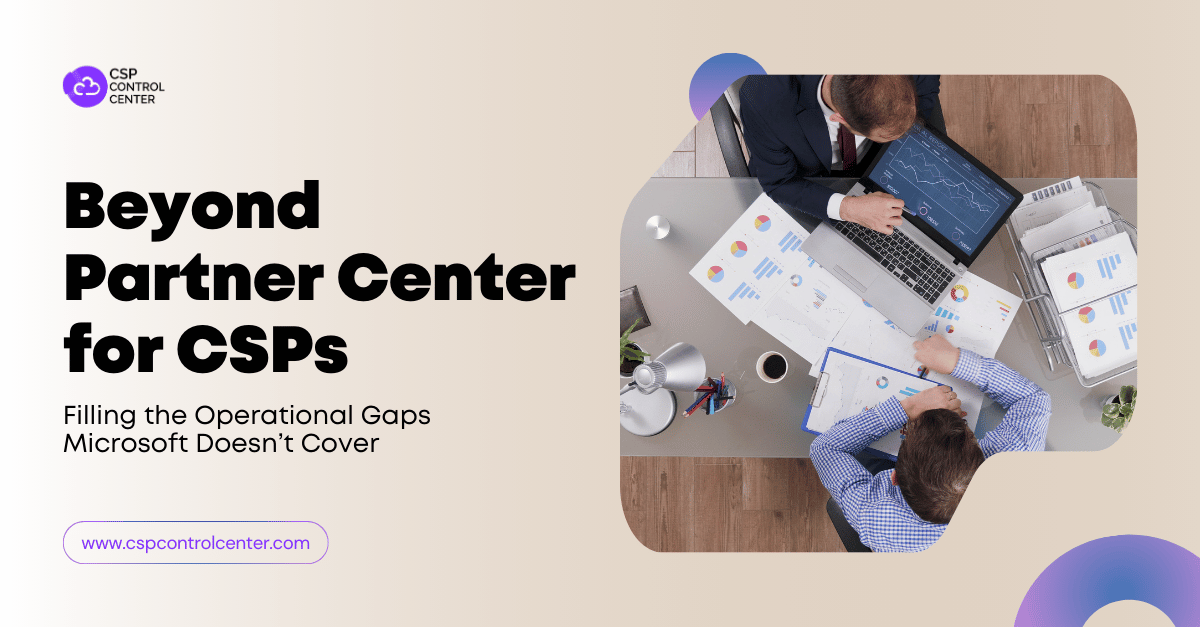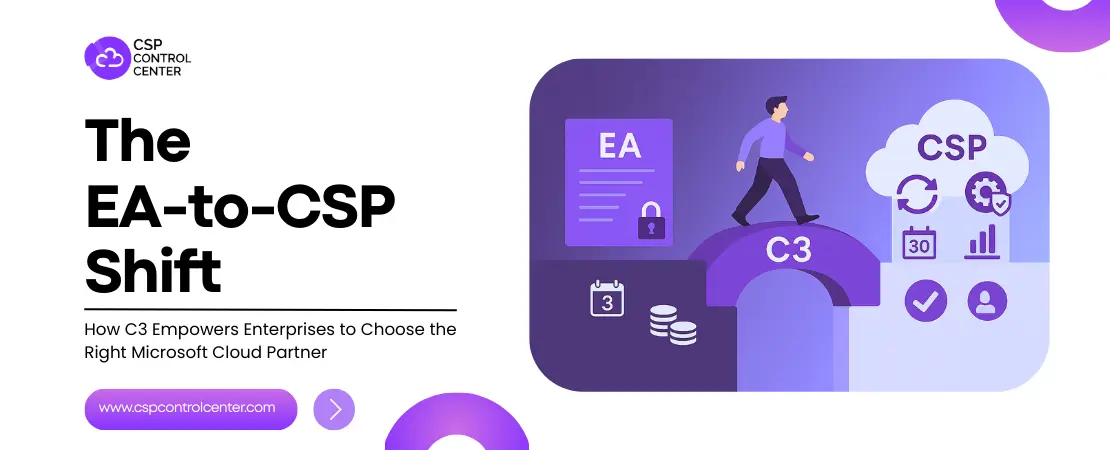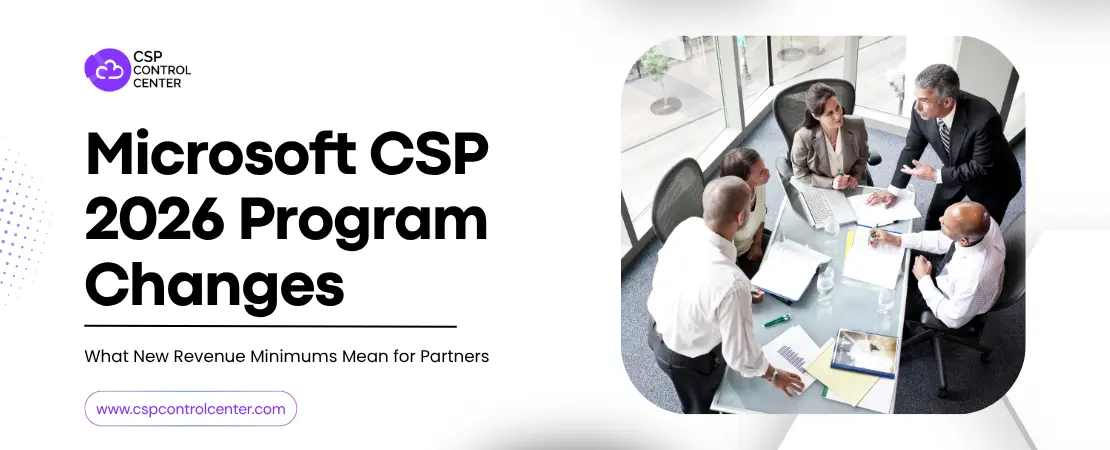The Microsoft Cloud Solution Provider (CSP) program enables you to move beyond simple license resale and manage end-to-end customer lifecycle, allowing you to build deep, lasting relationships. The Microsoft Partner Center is your gateway to managing subscriptions, billing, and customer relationships in the Microsoft Cloud ecosystem. If you are starting your CSP journey, Microsoft Partner Center offers you the tools you need to manage customer accounts, subscriptions, licenses, and billing. While it is good for entry and mid-level CSPs, it is not designed to handle the end-to-end operational demands of a growing CSP business. As your business grows, so do your operational needs; you have to manage thousands of licenses, handle custom billing models, streamline support, and offer value-added services.
To thrive in a highly competitive cloud market, you need more than just the basics. You need to streamline operations, enhance customer experience, and maintain healthy margins. The limitations of Partner Center can create bottlenecks and force you to rely on manual processes that drain your resources and hinder growth. Furthermore, as Microsoft continues to evolve its cloud offerings and CSP program requirements, the operational complexity only increases. New services, pricing changes, and program updates require you to adapt quickly, but the basic features of Partner Center often aren’t flexible enough to keep up.
This blog explores the specific operational gaps in Microsoft Partner Center, how they impact CSP businesses, and what tools can bridge these gaps to drive growth and efficiency.
Identifying Gaps in Microsoft Partner Center
While Microsoft Partner Center offers essential tools for subscription management, billing, and customer administration, it leaves several operational needs unaddressed. Understanding the limitations of the Microsoft Partner Center is the first step towards building a more efficient and profitable cloud business. Below are the most critical operational gaps in the Microsoft Partner Center that you may encounter while scaling your Microsoft CSP business.
Limited Billing & Invoicing Capabilities
Partner Center provides only basic invoicing, and essential billing reconciliation files. It lacks the flexibility to generate professional, customizable invoices that can be sent directly to end customers. It also does not provide any support for complex pricing models, such as tiered pricing, usage-based billing, or custom discounts. Calculating accurate prorated charges for mid-cycle additions or changes, especially under the complexities of the New Commerce Experience (NCE) rules, can become quite difficult.
Poor Multi-Currency & Tax Compliance Support
If you serve customers across multiple regions, you might face challenges with Partner Center’s limited support for localized tax rules, currency conversions, and region-specific compliance needs. You will have to manually calculate VAT, GST, sales tax, or other taxes for different regions and handle currency conversions that can lead to errors. This also leads to operational inefficiency and a risk of non-compliance.
No Advanced Analytics or Profitability Tracking
Partner Center offers basic reports on subscription usage and billing, but it doesn’t give you the advanced analytics you need to track profitability, monitor margins, or understand customer behavior. This gap makes strategic decision-making more difficult. Without clear visibility into which customers, services, or segments are most profitable, you may struggle to optimize your offerings and sales strategies. You will also be unable to identify underperforming accounts or recognize upselling opportunities, leading to potential revenue loss.
Absence of Customer Self-Service
Customers expect to have more control over their subscriptions and accounts and expect some level of self-service capability. They demand a self-service portal where they can view and pay invoices without contacting support, upgrade/downgrade subscriptions as per need, and access usage reports in real time. As the Microsoft Partner Centre is designed for CSPs and not end-customer access, you have to handle routine customer requests manually, increasing operational costs and potentially slowing response times.
Integration Limitations
As a CSP, you might be dependent on multiple systems for running your operations smoothly. Partner Center offers limited ability to connect seamlessly with them. It lacks pre-built, robust integrations with common business systems like CRM (Salesforce, HubSpot), PSA (ConnectWise Manage, Autotask), or accounting software (QuickBooks, Xero). This forces manual data re-entry between systems, leading to inefficiency, inconsistencies, and errors.
Lack of Ticketing and Support Management
Delivering effective customer support is essential for retaining customers, but Partner Center doesn’t include a robust ticketing or support management system. The ticketing function within Partner Center is solely for the CSP to raise support issues with Microsoft. You have to implement separate systems for tracking and resolving customer issues. And without seamless integration with other business tools, you struggle to connect support tickets with specific subscriptions or services, complicating troubleshooting and potentially extending resolution times.
Inadequate License Automation & Control
As your customer base grows, the complexity of managing a large number of licenses increases. Partner Center lacks automation for provisioning, deprovisioning, or adjusting licenses based on usage or customer requests. This means you have to manually manage licenses, which can increase administrative costs and lead to over-provisioning or under-provisioning of licenses.
Inability to Manage Bundled Services & Add-ons Seamlessly
You likely differentiate your offerings by bundling Microsoft services with your managed services, third-party software, or custom solutions. However, Partner Center doesn’t support the creation, pricing, unified billing, and management of these bundled offerings. This complicates product management, pricing strategies, and customer communications. Customers may receive multiple invoices for what they perceive as a single service bundle, which creates confusion.
Why These Gaps Hurt CSP Businesses
Operational gaps in Microsoft Partner Center can lead to financial inefficiencies and strategic setbacks for CSPs. Discover how these limitations affect growth, customer service, and competitiveness.
High Operational Overhead
The extensive manual efforts required for tasks like complex billing calculations, invoice generation, reconciliation, license provisioning, and support take up a lot of time and resources. As your customer base expands, so does the complexity of maintaining spreadsheets for billing, tax, and licensing. This results in high labor costs for finance, operations, and support teams.
Revenue Leakage and Lost Opportunities
Manual billing processes can lead to inaccuracies, missed charges, or delayed invoicing. Unbilled services missed price increases, and inaccurate usage tracking can impact your profitability. As per MGI Research, “42% of companies experience revenue leakage.” Without analytics or profitability tracking, you might miss underperforming services, fail to optimize pricing, or lose revenue from over-provisioned licenses.
Slow Service Delivery
Limited automation within the Microsoft Partner Center causes delays in provisioning, customer onboarding, and upgrading or downgrading licenses. This leads to customers getting frustrated with the slow service delivery and negatively impacts license renewals. According to Zendesk Benchmark data, “73% of consumers will switch to a competitor after multiple bad experiences.”
Inability to Scale Effectively
Manual processes make it difficult to scale your Microsoft CSP business. Without automation and integration, you can’t efficiently manage large customer bases or expand into new markets.
Risk of Compliance Issues
Improper tax calculations, missed renewals, or incorrect license assignments can quickly lead to non-compliance with Microsoft policies or regional regulations. These mistakes not only lead to financial penalties but also erode the trust customers have in you.
Competitive Disadvantage
In a highly competitive market, if you are unable to provide flexible pricing, accurate invoicing, or self-service capabilities, then you are at risk of losing deals to your competitors. Customers look for service providers who offer seamless experience and better visibility in their services. If you are only depending on the Partner Centre, then you will not limit your ability to innovate, customize, and differentiate.
Lack of Strategic Insight
In the absence of analytics and profitability tracking, making informed decisions about pricing strategies, identifying your most (and least) profitable customers or services, optimizing resource allocation, or forecasting accurately becomes incredibly difficult.
What CSPs Need to Fill These Gaps
To overcome Partner Center’s limitations and build a truly efficient CSP operation, you need a complementary set of capabilities that enhance your workflows. Simply accepting the operational constraints of Partner Center puts your business at a competitive disadvantage and limits your growth potential. You need tools and processes that support:
End-to-End Automated Billing
You need a tool that can generate custom and professional-looking invoices. The tool should consolidate all customer services, including Microsoft subscriptions, your managed services, and third-party offerings into a single, comprehensive bill.
This billing system should handle complex billing scenarios, including tiered pricing structures, volume discounts, custom billing cycles, and promotional pricing. This not only reduces administrative workload but also improves cash flow and billing accuracy
Real-Time License Management
With hundreds or thousands of licenses to manage across multiple customers, real-time license provisioning and deprovisioning are essential. Partner Center doesn’t offer the automation or visibility needed to manage licenses on a scale. You need a tool that can automate license changes in real time, monitor usage, and alert you to under- or over-utilized subscriptions. The tool should also be able to handle large customer deployments efficiently. These features ensure accurate billing, minimize revenue leakage, and maintain compliance with Microsoft’s licensing policies.
Global Tax & Multi-Currency Compliance
It is very important that your tax and currency calculations are always correct. You need tools that support accurate tax calculations based on location, handle local invoicing formats, and support multi-currency billing. The system should also be able to generate audit-ready tax reports to simplify tax filings. Automating these complex tax and currency calculations significantly reduces the risk of costly non-compliance penalties and ensures financial accuracy
Self-Service Portals for Customers
Self-service empowers customers to be more in control of their subscriptions and allows them to manage certain routine tasks without needing any support from your team. You need to provide your customers with a dedicated, secure, and branded self-service portal. Using the self-service portal, the customers should be able to view detailed subscription information and current license assignments, monitor their real-time usage, adjust license quantities, or request upgrades/downgrades, view current and past invoices, make online payments, raise support tickets, and track them.
Advanced Analytics & Profitability Insights
To make better business decisions, you need more than the basic data that is provided by the Partner Center. You need deep and actionable insight on profitability, margins, customer behavior, and service performance. These tools should help you identify your most profitable customers, spot upsell opportunities and detect underperforming services. With the right data, you can refine pricing strategies, allocate resources effectively, and make informed decisions to boost growth and profitability.
Seamless Business Integrations
You might be using a number of business tools like CRM, PSA, accounting software, etc. You need a platform with pre-built integrations that can sync subscriptions, invoices, and customer data automatically. These integrations ensure data flows smoothly across different business tools, eliminate manual re-entry, and reduce errors. By connecting different tools, you streamline operations and gain a unified view of customer interactions, billing, and support.
Unified Product & Bundle Management
One of the ways to differentiate your Microsoft CSP business is to offer bundles that combine Microsoft cloud products with your own managed services or third-party tools. You need a solution that simplifies the creation, pricing, billing, and tracking of bundled offerings. This capability allows you to present customers with a single, cohesive invoice for all services, improving transparency and simplifying their experience.
Your Next Steps: Moving Beyond the Basics
By analyzing the operational gaps in the Partner Center and its impact on Microsoft CSP business, it is quite clear that Microsoft Partner Center’s basic tools are not capable of fully supporting business growth. If you are planning to move beyond the Partner Center, you need a strategic approach that addresses operational gaps and enhances customer experiences. Here are seven actionable steps to move beyond Partner Center:
Step 1: Map Your Current Operational Challenges
Before implementing new tools, you need a clear understanding of the operational challenges your business faces. You can start by auditing end-to-end workflows and identify areas where Partner Center creates bottlenecks. It could be manual billing, license management, or customer support. Document the pain points and involve your finance, operations, and support teams to understand the impact of inefficiencies on cost and customer experience. Not all operational gaps will have the same business impact. Prioritize gaps that directly impact revenue, scalability, or customer retention, such as inaccurate billing, lack of analytics, or poor integration with other business tools
Step 2: Explore Tools that Align with Your Needs
Not every automation tool will work seamlessly with the Microsoft CSP program. You need to research tools that are specifically designed keeping in mind the complexities of the Microsoft CSP ecosystem. Look for solutions with strong, reliable integration with Partner Center, positive feedback from other CSPs, and features that directly address your prioritized gaps, like automated billing, real-time license management, global tax compliance, self-service portals, advanced analytics, etc. Request demos and compare features to find a tool that matches your business size and goals. Read our blog on Top 9 features to look for in your Microsoft CSP billing tool to learn more.
Step 3: Plan for Integration with Existing Systems
Any new platform you choose must integrate seamlessly with your existing business tools. Evaluate how potential solutions integrate with your CRM, PSA, and accounting software. Aim for seamless, bi-directional data flow to eliminate manual data entry and ensure consistency across platforms. Identify potential integration challenges early and discuss solutions with vendors.
Step 4: Pilot and Migrate Gradually
Start by piloting the new platform with a small customer segment or specific services. This approach minimizes risk while allowing your team to learn and adapt. Test critical functions like billing, license provisioning, and customer self-service. Gather feedback from your team and customers to identify issues early. Use the learnings from the pilot to refine processes before initiating migration across the rest of your business.
Step 5: Train Your Team
The success of any business tool depends on the ability and willingness of the team using it. Invest in comprehensive training to ensure your team can leverage the platform’s features. Provide role-based training, like finance teams on using billing dashboards and support teams on handling self-service portal tickets. Do not limit the training to only talking about the features also tell your team why you are changing the processes and how it will benefit them and the business.
Step 6: Optimize & Scale
After implementation, monitor performance metrics like billing accuracy, provisioning speed, and customer satisfaction. Gather feedback from your team and customers on the performance of the new tool. As your business grows, leverage the platform’s scalability to handle larger customer bases, new markets, or additional services without adding complexity.
Step 7: Plan for Future Microsoft Changes
Microsoft frequently updates its CSP program, introducing new services, pricing models, or compliance requirements like the New Commerce Experience (NCE). Stay informed through Microsoft’s announcements and ensure your platform provider offers regular updates to align with these changes.
Ready to Fill the Operational Gaps in Your CSP Business?
Microsoft Partner Center is a strong starting point—but it’s not enough to scale a competitive CSP business. If you’re struggling with manual billing, limited analytics, disconnected systems, or poor customer experience, it’s time to level up.
CSP Control Center is purpose-built to extend and enhance what Partner Center lacks. Automate complex billing, manage licenses in real time, enable customer self-service, and gain profitability insights—all from a unified platform that integrates with your existing tools.
Stop patching operational holes. Start building a CSP business that’s efficient, scalable, and future-ready.
Book a demo today and start transforming your CSP operations.

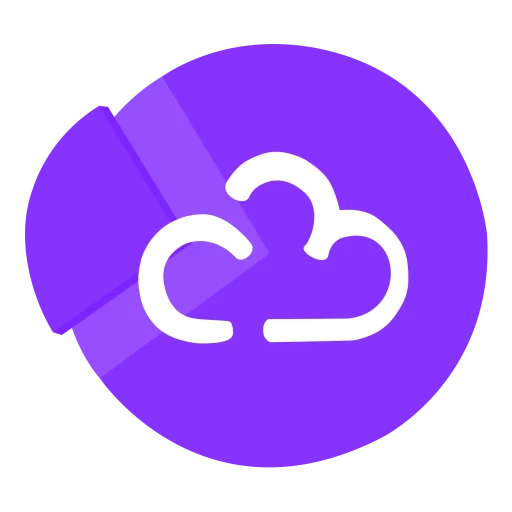 CSP Control Center
CSP Control Center
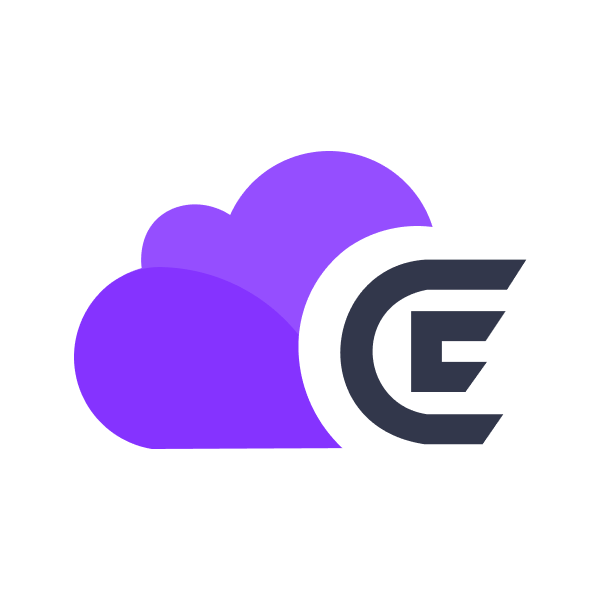 CloudEvents
CloudEvents
